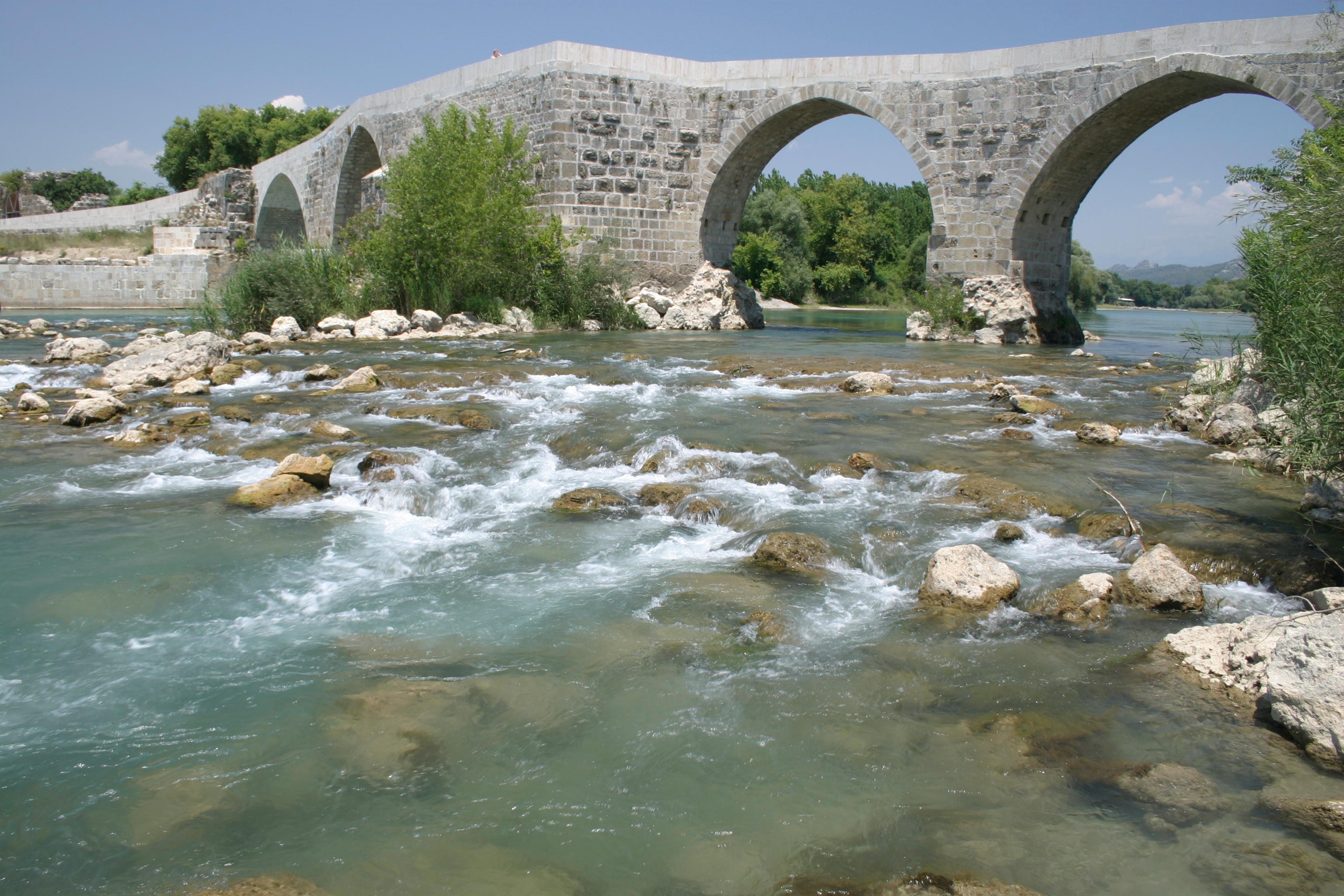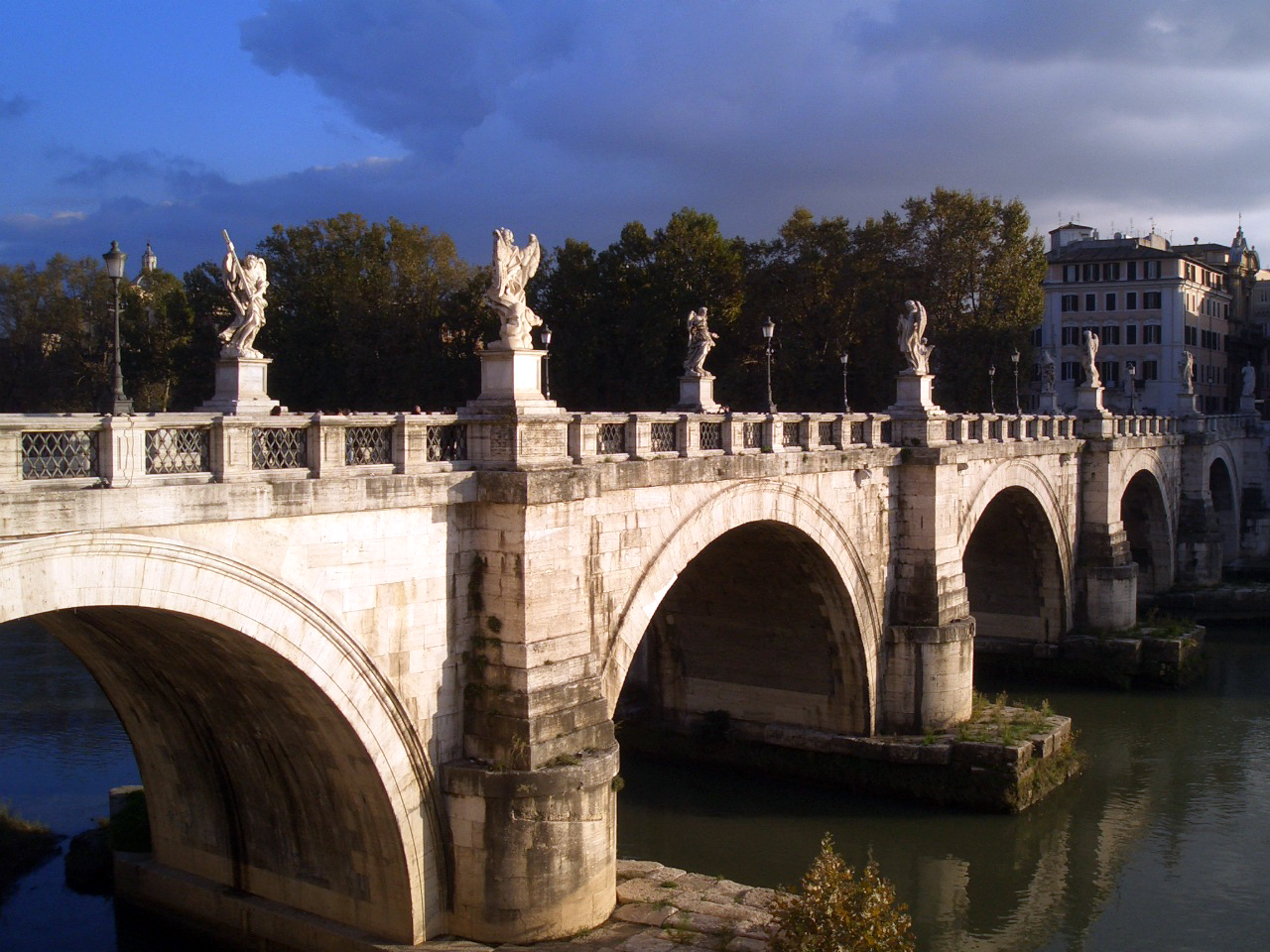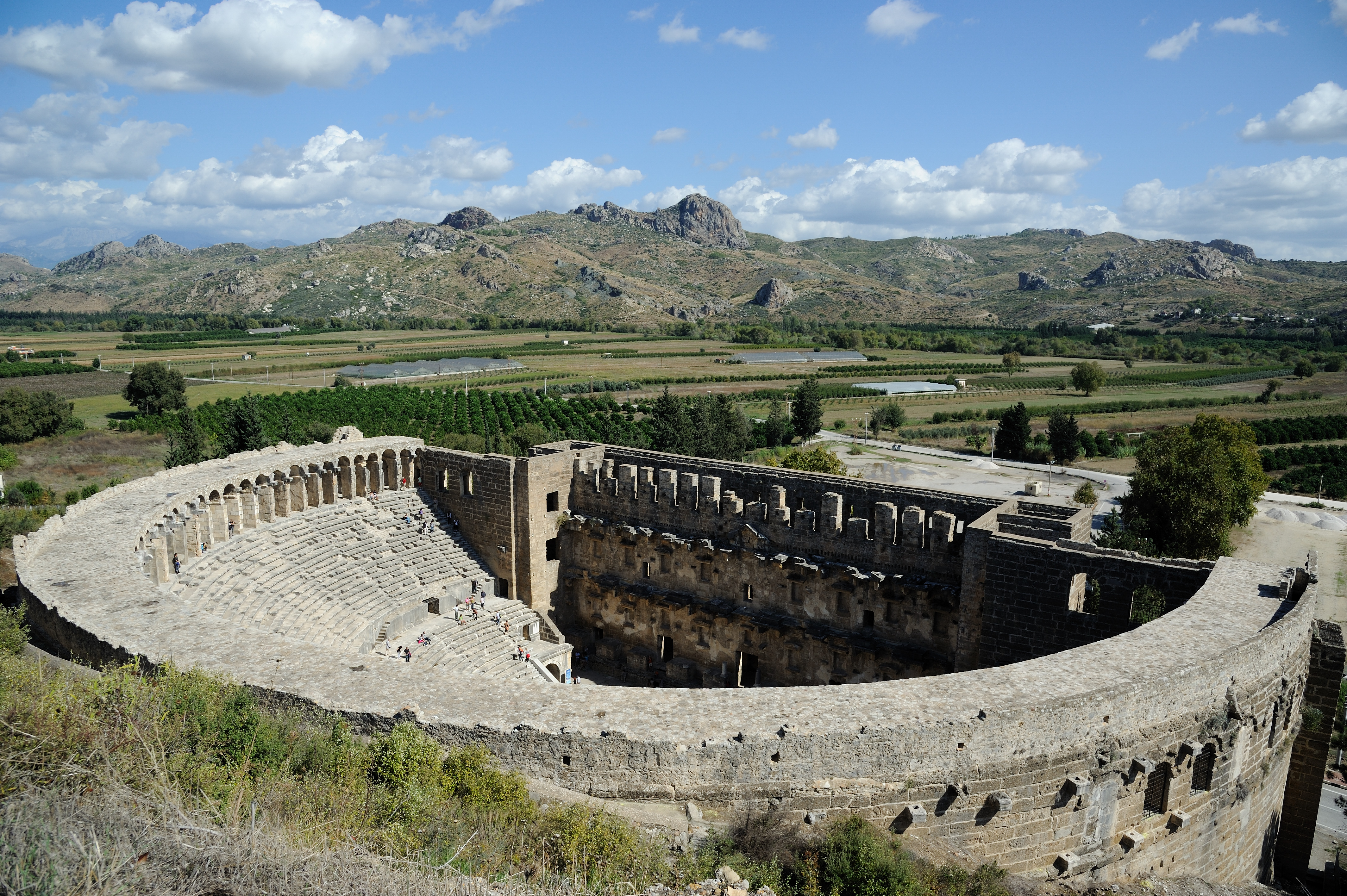|
Eurymedon Bridge (Aspendos)
The Eurymedon Bridge was a late Roman bridge over the river Eurymedon (modern ''Köprüçay''), near Aspendos, in Pamphylia in southern Anatolia. The foundations and other stone blocks (''spolia'') of the Roman structure were used by the Seljuqs to build a replacement bridge in the 13th century, the Köprüpazar Köprüsü, which stands to this day. This bridge is characterized by a significant displacement along its mid-line, noticeable by looking at its ancient piers. Roman bridge Structure The original shape and construction of the Roman-era bridge have been reconstructed digitally, based on the extant remains of the ancient structure: the ramps, the abutments, and foundations of the piers. Several pieces of the original bridge are scattered along the river bed on both banks, and were not used during reconstruction. Originally, the bridge had a length of 259.50 m and a width of 9.44 m, and had nine semicircular arches. It crossed the river at a basic 90-degr ... [...More Info...] [...Related Items...] OR: [Wikipedia] [Google] [Baidu] |
Eurymedon River
Eurymedon may refer to: Historical figures *Eurymedon (strategos) (died 413 BC), one of the Athenian generals (strategoi) during the Peloponnesian War *Eurymedon of Myrrhinus, married Plato's sister, Potone; he was the father of Speusippus * Eurymedon the hierophant, the representative of Eleusinian Demetra; together with the school of Isocrates and Demophilos they brought a charge of impiety against Aristotle Greek mythology *Eurymedon (mythology) Geography *Eurymedon River, now Köprüçay River * Eurymedon Bridge (Aspendos), over this river at Aspendos * Eurymedon Bridge (Selge), over this river at Selge Other uses * 5012 Eurymedon, asteroid *''The Eurymedon'', alternative name for '' New Zealand Shipping Co. Ltd. v. A. M. Satterthwaite & Co. Ltd.'' court case * Eurymedon vase, an Attic red-figure ''oinochoe'', a wine jug attributed to the circle of the Triptolemos Painter made ca. 460 BC, which is now in the ''Museum für Kunst und Gewerbe Hamburg'' (1981.173) See ... [...More Info...] [...Related Items...] OR: [Wikipedia] [Google] [Baidu] |
Spillway
A spillway is a structure used to provide the controlled release of water downstream from a dam or levee, typically into the riverbed of the dammed river itself. In the United Kingdom, they may be known as overflow channels. Spillways ensure that water does not damage parts of the structure not designed to convey water. Spillways can include floodgates and fuse plugs to regulate water flow and reservoir level. Such features enable a spillway to regulate downstream flow—by releasing water in a controlled manner before the reservoir is full, operators can prevent an unacceptably large release later. Other uses of the term "spillway" include bypasses of dams and outlets of channels used during high water, and outlet channels carved through natural dams such as moraines. Water normally flows over a spillway only during flood periods, when the reservoir has reached its capacity and water continues entering faster than it can be released. In contrast, an intake tower is a structure ... [...More Info...] [...Related Items...] OR: [Wikipedia] [Google] [Baidu] |
Eurymedon Bridge (Selge)
The Eurymedon Bridge ( tr, Oluk Köprü) is a Roman bridge over the river Eurymedon (modern Köprüçay River) near Selge in Pisidia in southern Turkey. It is part of the road winding up from the coastal region Pamphylia to the Pisidian hinterland. Located 5 km north of the village Beşkonak in a sparsely settled area, the bridge crosses the Eurymedon high above the valley bottom. The excellently preserved structure is 14 m long and 3.5 m wide (with a roadway of 2.5 m). The clear span of its single arch is c. 7 m, the thickness of its voussoirs, which were set without the use of mortar, 60 cm. The building technique and the sturdy stonework point to a construction date in the 2nd century AD, a time when Selge was flourishing. Forty-two km downstream at Aspendos, the Eurymedon is crossed by another extant old bridge. Gallery File:Eurymedon Bridge 5066.jpg, File:Eurymedon Bridge 5058.jpg, File:Eurymedon Bridge 5051.jpg, File:Köprülü Kanyon ... [...More Info...] [...Related Items...] OR: [Wikipedia] [Google] [Baidu] |
List Of Roman Bridges
This is a list of Roman bridges. The Romans were the world's first major bridge builders. The following list constitutes an attempt to list all known surviving remains of Roman bridges. A Roman bridge in the sense of this article includes any of these features: *Roman arches *Roman pillars *Roman foundations *Roman abutments *Roman roadway *Roman cutwaters Also listed are bridges which feature substantially Roman material (spolia), as long as the later bridge is erected on the site of a Roman precursor. Finally, incidences where only inscriptions lay testimony to a former Roman bridge are also included. In the following, bridges are classified either according to their material or their function. Most data not otherwise marked come from O’Connor's ''Roman Bridges'', which lists 330 stone bridges for traffic, 34 timber bridges and 54 aqueduct bridges. An even larger compilation of more than 900 Roman bridges (as of 2011) is offered by the Italian scholar Galliazzo, who is ... [...More Info...] [...Related Items...] OR: [Wikipedia] [Google] [Baidu] |
Arabic Language
Arabic (, ' ; , ' or ) is a Semitic language spoken primarily across the Arab world.Semitic languages: an international handbook / edited by Stefan Weninger; in collaboration with Geoffrey Khan, Michael P. Streck, Janet C. E.Watson; Walter de Gruyter GmbH & Co. KG, Berlin/Boston, 2011. Having emerged in the 1st century, it is named after the Arab people; the term "Arab" was initially used to describe those living in the Arabian Peninsula, as perceived by geographers from ancient Greece. Since the 7th century, Arabic has been characterized by diglossia, with an opposition between a standard prestige language—i.e., Literary Arabic: Modern Standard Arabic (MSA) or Classical Arabic—and diverse vernacular varieties, which serve as mother tongues. Colloquial dialects vary significantly from MSA, impeding mutual intelligibility. MSA is only acquired through formal education and is not spoken natively. It is the language of literature, official documents, and formal written m ... [...More Info...] [...Related Items...] OR: [Wikipedia] [Google] [Baidu] |
Greek Language
Greek ( el, label=Modern Greek, Ελληνικά, Elliniká, ; grc, Ἑλληνική, Hellēnikḗ) is an independent branch of the Indo-European family of languages, native to Greece, Cyprus, southern Italy (Calabria and Salento), southern Albania, and other regions of the Balkans, the Black Sea coast, Asia Minor, and the Eastern Mediterranean. It has the longest documented history of any Indo-European language, spanning at least 3,400 years of written records. Its writing system is the Greek alphabet, which has been used for approximately 2,800 years; previously, Greek was recorded in writing systems such as Linear B and the Cypriot syllabary. The alphabet arose from the Phoenician script and was in turn the basis of the Latin, Cyrillic, Armenian, Coptic, Gothic, and many other writing systems. The Greek language holds a very important place in the history of the Western world. Beginning with the epics of Homer, ancient Greek literature includes many works of lasting impo ... [...More Info...] [...Related Items...] OR: [Wikipedia] [Google] [Baidu] |
Late Antiquity
Late antiquity is the time of transition from classical antiquity to the Middle Ages, generally spanning the 3rd–7th century in Europe and adjacent areas bordering the Mediterranean Basin. The popularization of this periodization in English has generally been credited to historian Peter Brown, after the publication of his seminal work '' The World of Late Antiquity'' (1971). Precise boundaries for the period are a continuing matter of debate, but Brown proposes a period between the 3rd and 8th centuries AD. Generally, it can be thought of as from the end of the Roman Empire's Crisis of the Third Century (235–284) to the early Muslim conquests (622–750), or as roughly contemporary with the Sasanian Empire (224–651). In the West its end was earlier, with the start of the Early Middle Ages typically placed in the 6th century, or earlier on the edges of the Western Roman Empire. The Roman Empire underwent considerable social, cultural and organizational changes starting wit ... [...More Info...] [...Related Items...] OR: [Wikipedia] [Google] [Baidu] |
Kayqubad I
Alā ad-Dīn Kayqubād ibn Kaykhusraw ( fa, علاء الدين كيقباد بن كيخسرو; tr, I. Alâeddin Keykûbad, 1190–1237), also known as Kayqubad I, was the Seljuq Sultan of Rûm who reigned from 1220 to 1237. He expanded the borders of the sultanate at the expense of his neighbors, particularly the Mengujek Beylik and the Ayyubids, and established a Seljuq presence on the Mediterranean with his acquisition of the port of Kalon Oros , later renamed Ala'iyya in his honor. The sultan, sometimes styled Kayqubad the Great, is remembered today for his rich architectural legacy and the brilliant court culture that flourished under his reign. Kayqubad's reign represented the apogee of Seljuq power and influence in Anatolia, and Kayqubad himself was considered the most illustrious prince of the dynasty. In the period following the mid-13th century Mongol invasion, inhabitants of Anatolia frequently looked back on his reign as a golden age, while the new rulers of t ... [...More Info...] [...Related Items...] OR: [Wikipedia] [Google] [Baidu] |
Earthquake
An earthquake (also known as a quake, tremor or temblor) is the shaking of the surface of the Earth resulting from a sudden release of energy in the Earth's lithosphere that creates seismic waves. Earthquakes can range in intensity, from those that are so weak that they cannot be felt, to those violent enough to propel objects and people into the air, damage critical infrastructure, and wreak destruction across entire cities. The seismic activity of an area is the frequency, type, and size of earthquakes experienced over a particular time period. The seismicity at a particular location in the Earth is the average rate of seismic energy release per unit volume. The word ''tremor'' is also used for Episodic tremor and slip, non-earthquake seismic rumbling. At the Earth's surface, earthquakes manifest themselves by shaking and displacing or disrupting the ground. When the epicenter of a large earthquake is located offshore, the seabed may be displaced sufficiently to cause ... [...More Info...] [...Related Items...] OR: [Wikipedia] [Google] [Baidu] |
Terminus Post Quem
''Terminus post quem'' ("limit after which", sometimes abbreviated to TPQ) and ''terminus ante quem'' ("limit before which", abbreviated to TAQ) specify the known limits of dating for events or items.. A ''terminus post quem'' is the earliest date the event may have happened or the item was in existence, and a ''terminus ante quem'' is the latest. An event may well have both a ''terminus post quem'' and a ''terminus ante quem'', in which case the limits of the possible range of dates are known at both ends, but many events have just one or the other. Similarly, ''terminus ad quem'' ("limit to which") is the latest possible date of a non-punctual event (period, era, etc.), while ''terminus a quo'' ("limit from which") is the earliest. The concepts are similar to those of upper and lower bounds in mathematics. These terms are often used in archaeological and historical studies, such as dating layers in excavated sites, coins, historical events, authors, inscriptions or texts wher ... [...More Info...] [...Related Items...] OR: [Wikipedia] [Google] [Baidu] |
Roman Aqueduct
The Romans constructed aqueducts throughout their Republic and later Empire, to bring water from outside sources into cities and towns. Aqueduct water supplied public baths, latrines, fountains, and private households; it also supported mining operations, milling, farms, and gardens. Aqueducts moved water through gravity alone, along a slight overall downward gradient within conduits of stone, brick, concrete or lead; the steeper the gradient, the faster the flow. Most conduits were buried beneath the ground and followed the contours of the terrain; obstructing peaks were circumvented or, less often, tunneled through. Where valleys or lowlands intervened, the conduit was carried on bridgework, or its contents fed into high-pressure lead, ceramic, or stone pipes and siphoned across. Most aqueduct systems included sedimentation tanks, which helped to reduce any water-borne debris. Sluices, ''castella aquae'' (distribution tanks) and stopcocks regulated the supply to individual de ... [...More Info...] [...Related Items...] OR: [Wikipedia] [Google] [Baidu] |
Aspendos Aquaedukt
Aspendos or Aspendus ( Pamphylian: ΕΣΤϜΕΔΥΣ; Attic: Ἄσπενδος) was an ancient Greco-Roman city in Antalya province of Turkey. The site is located 40 km east of the modern city of Antalya. It was situated on the Eurymedon River about 16 km inland from the Mediterranean Sea; it shared a border with, and was hostile to, the ancient city of Side. History The wide range of its coinage throughout the ancient world indicates that, in the 5th century BC, Aspendos had become the most important city in Pamphylia. At that time, according to Thucydides, the Eurymedon River was navigable as far as Aspendos, and the city derived great wealth from a trade in salt, oil and wool. Aspendos did not play an important role in antiquity as a political force. Its political history during the colonisation period corresponded to the currents of the Pamphylian region. Within this trend, after the colonial period, it remained for a time under Lycian hegemony. In 546 BC, ... [...More Info...] [...Related Items...] OR: [Wikipedia] [Google] [Baidu] |









